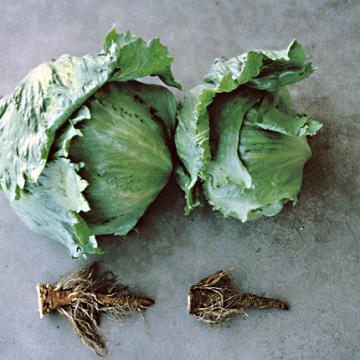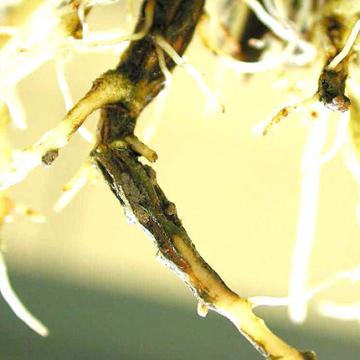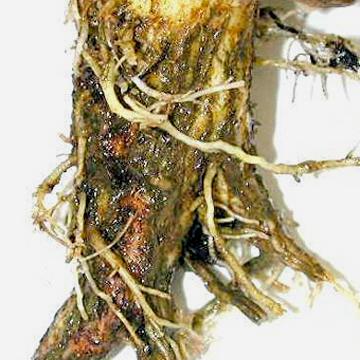DISEASE: Corky root
HOST: Lettuce
Corky root causes a reduction in size of lettuce heads and root systems; susceptible cultivar (right) and resistant cultivar (left).

Corky root | Lettuce
DISEASE: Corky root
HOST: Lettuce (Lactuca sativa)
PATHOGEN: Sphingomonas suberifaciens
PATHOGEN SYNONYM: Rhizomonas suberifaciens
SOURCE: E. J. Ryder
DISEASE: Corky root
HOST: Lettuce
Close-up of root with malformed, corky appearance and longitudinal ridges of brown tissues.

Corky root | Lettuce
DISEASE: Corky root
HOST: Lettuce (Lactuca sativa)
PATHOGEN: Sphingomonas suberifaciens
PATHOGEN SYNONYM: Rhizomonas suberifaciens
SOURCE: A. van Bruggen
DISEASE: Corky root
HOST: Lettuce
Initial symptoms of disease are yellow lesions on taproot and main laterals. Greenish brown bands occur around roots. Root pith may become brown and hollow.
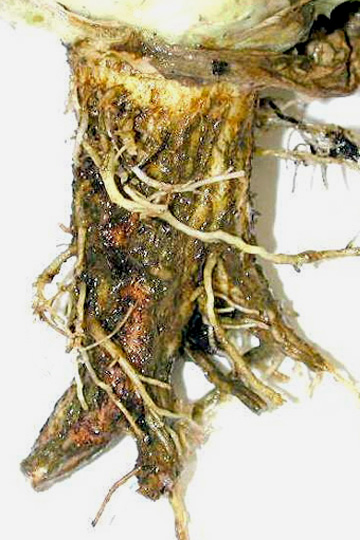
Corky root | Lettuce
DISEASE: Corky root
HOST: Lettuce (Lactuca sativa)
PATHOGEN: Sphingomonas suberifaciens
PATHOGEN SYNONYM: Rhizomonas suberifaciens
SOURCE: A. van Bruggen
DISEASE: Corky root
HOST: Lettuce
Differences in corky root symptoms between susceptible cultivar (right) and resistant cultivar (left).
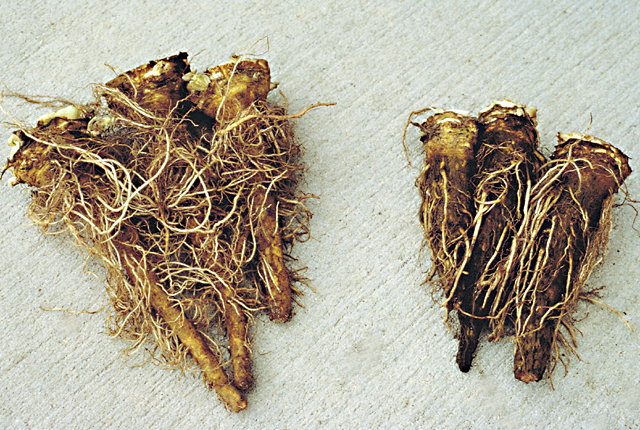
Corky root | Lettuce
DISEASE: Corky root
HOST: Lettuce (Lactuca sativa)
PATHOGEN: Sphingomonas suberifaciens
PATHOGEN SYNONYM: Rhizomonas suberifaciens
SOURCE: E. Ryder
DISEASE: Olive knot
HOST: Olive
Multiple infections of young stems. The bacterium invades vascular tissues during certain times of the year and may be isolated from branches that appear healthy.

Olive knot | Olive
DISEASE: Olive knot
HOST: Olive (Olea europaea)
PATHOGEN: Pseudomonas savastanoi pv. savastanoi
SOURCE: M. Schroth
DISEASE: Olive knot
HOST: Olive
Tree with knots/galls on branches along with twig dieback, which is associated with knots. Fusarium and Diplodia spp. infect through knots and are thought to be main reason for dieback.

Olive knot | Olive
DISEASE: Olive knot
HOST: Olive (Olea europaea)
PATHOGEN: Pseudomonas savastanoi pv. savastanoi
SOURCE: M. Schroth
DISEASE: Olive knot
HOST: Olive
Multiple infections on olive branch. Knots at this stage begin to die from the outside in and are infected by several fungi.

Olive knot | Olive
DISEASE: Olive knot
HOST: Olive (Olea europaea)
PATHOGEN: Pseudomonas savastanoi pv. savastanoi
SOURCE: M. Schroth
DISEASE: Pink disease
HOST: Pineapple
Infected pineapple slices; effect of heating (right) and not heating (left).
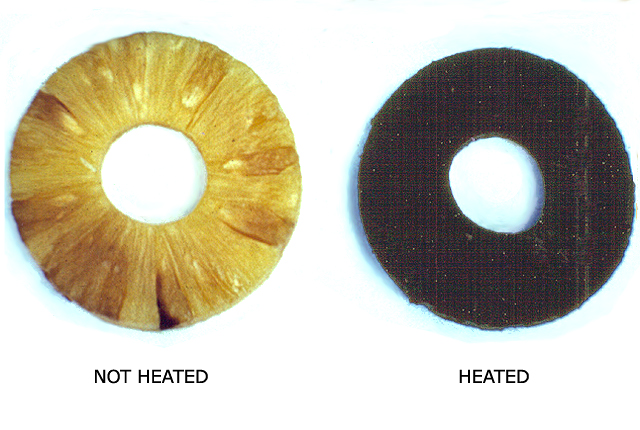
Pink disease | Pineapple
DISEASE: Pink disease
HOST: Pineapple (Ananas comosus)
PATHOGEN: Tatumella citrea
PATHOGEN SYNONYM: Pantoea citrea
SOURCE: K. Rohrbach, A. Alvarez
DISEASE: Pink disease
HOST: Pineapple
Two clones (A and D) showing different stages of infection. Second and fourth fruits (left to right) have been heated. Disease originally attributed to Gluconobacter oxydans and Enterobacter agglomerans and later to Pantoea citrea.
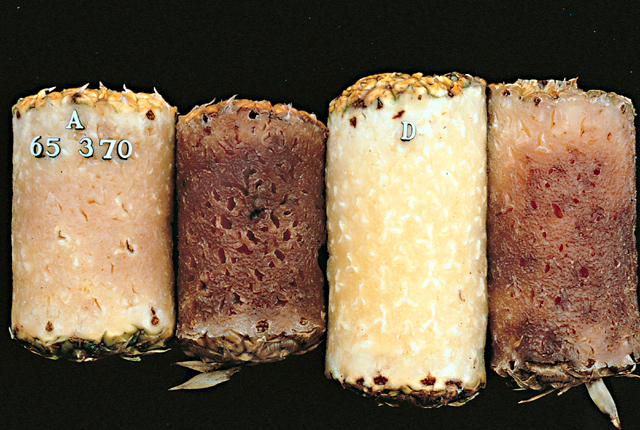
Pink disease | Pineapple
DISEASE: Pink disease
HOST: Pineapple (Ananas comosus)
PATHOGEN: Tatumella citrea
PATHOGEN SYNONYM: Pantoea citrea
SOURCE: K. Rohrbach


